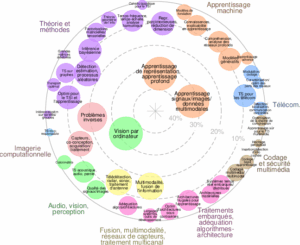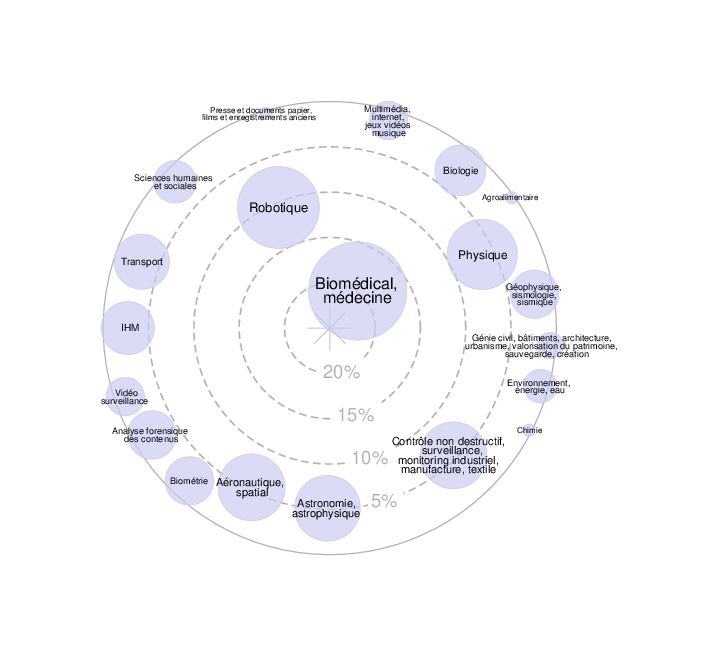Lieu : Laboratoire ImViA, Dijon (France)
| Description This research takes place in a collaborative project between a small-size industrial company (CMPHy) and a Vision and Artificial Intelligence academic research laboratory ImViA at Université Bourgogne Europe. CMPhy is a company located in Chalon-sur-Saone, which specialized itself in developing advanced Non-Destructive Testing (NDT) machines based on (but not limited to) electromagnetic field effect. ImViA is based in Dijon and Le Creusot and is developing academic research on non-conventional imaging and image processing associated (ML and IA models). The goal of the project is to estimate physical properties of materials, such as steel alloy, from several non-contact and non-destructive measurement techniques. Physical properties of materials include: residual strength, chemical composition, stiffness, tensile strength, finishing and heat treatment. The measurement methods that could be used to estimate the physical properties includes: hysteresis cycles, self-magnetic field intensity, microstructure, Berkhausen noise, and other electromagnetic sensors outputs to be developed during the project by CMPhy. Song et al. [1] have shown how to predict mechanical properties from microstructure and material composition, using a multimodal (2 inputs: image and tabular) deep-learning model, applied to composite material only. Transformer based approach are developed in [2] to estimate missing properties (elastic tensor, bulk modulus) from multimodal information (charge density, crystallography and text information). Also, Bayesian based methods are used in [3] to estimate strength from multimodal information (composition, grain size, etc.) and takes care of uncertainties. Papers [4,5] demonstrate the use of deep-learning approach to estimate mechanical steel properties. In conclusion, the goal is to develop a multimodal AI model (image, time-series measurements, 1D measurements) coupled with a dedicated dataset, in order to estimate the physical properties of materials. All measurement methods to be included in the prediction model must be calibrated. The dataset will be built during the project from the measurement techniques that must be accurately selected. The purposed timeline for the Ph.D thesis is as follow : – Year 1: literature review and database construction guideline to include further measurement techniques all along the thesis – Year 2: Database construction and model development and training. Inverse Problem methodology – Year 3: Include uncertainties measurement in the model. |
Bibliography
[1] S. Lei, W. Donglei, L. Xuwang, Y. Aijun and L. Zhendong. 2023. « Prediction of mechanical properties of composite materials using multimodal fusion learning ». Sensors and Actuators A: Physical 358:114433. https://doi.org/10.1016/j.sna.2023.114433.
[2] V. Moro, C. Loh, R. Dangovski, A. Ghorashi, A. Ma, Z. Chen, S. Kim, P. Y. Lu, T. Christensen and M. Soljačić. 2025. « Multimodal Foundation Models for Material Property Prediction and Discovery ». Newton 1 (1): 100016. https://doi.org/10.1016/j.newton.2025.100016.
[3] J. Chen, D. Ersoy and Y. Liu. 2020. « Probabilistic bulk property estimation using multimodality surface non-destructive measurements for vintage pipes ». Structural Safety 87:101995. https://doi.org/10.1016/j.strusafe.2020.101995.
[4] L. R. Botvina , M. R. Tyutin, V. P. Levin, A. V. Ioffe, Y. S. Perminova and D. V. Prosvirnin. 2021. « Mechanical and Physical Properties, Fracture Mechanisms, and Residual Strength of 15Kh2GMF Steel for Oil Sucker Rods ». Russian Metallurgy (Metally) 2021 (4): 546‑58. https://doi.org/10.1134/S0036029521040066.
[5] D. Ren, W. Chenchong, W. Xiaolu, L. Qingquan and X. Wei. 2023. « Building a quantitative composition-microstructure-property relationship of dual-phase steels via multimodal data mining ». Acta Materialia 252:118954. https://doi.org/10.1016/j.actamat.2023.118954.
Applicant profile
The ideal candidate has a Master degree and/or an Engineering degree in Physics, Signal processing or Materials. Candidates with majors in AI are welcome to apply.
The candidate must have:
– Good understanding of materials and instrumentation.
– Excellent communication skills in written and oral English.
Preferred selection criteria:
– Knowledge in: NDT techniques.
– Knowledge in: Object-Oriented Programming, Python, C++ (optional)
– Knowledge in: Vision, Multi-modal Deep-learning, applied machine learning and optimization.
– Enthusiasm for experimentation, instrumentation, teamwork, and capability of independent problem-solving.
Personal characteristics:
– Ability to work individually and a high level of personal responsibility.
– Ability to meet deadlines and produce work of a consistently high standard.
– High motivation for applied research work.
– Eager to disseminate research results through publications and presentations at both academic and industrial international conferences.
Funding: ANR (Project LabCom OPTEND)
Applications before 15/06/2025
Position start: 1er Octobre 2025
Salary (gross): 2200€ per month
Thesis Supervisor : Stéphanie Bricq (MCF-HDR) /Patrick Marquié (PR)
Hermine Chatoux (MCF), Julien Baumeyer (Ph.D)
Applications: Please send the following documents by email to Stéphanie Bricq (stephanie.bricq@ube.fr) by June 15th
– CV
– Cover letter
– Academic transcripts
– At least 1 reference letter or reference contact





